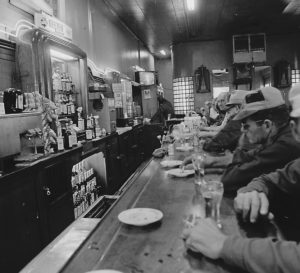.jpg)
Denver Police and a security officer watch the TV coverage of the Apollo 11 Moon Landing, Denver, CO, on a portable TV plugged into the cigarette lighter of the officer’s car. They were providing security, crowd and traffic control at an event in a local park, but took time to watch the landing. Sunday, July 20, 1969. Photograph taken on assignment for The Denver Post.
Well, I wasn’t on the moon covering this famous event, but covering the reaction around Denver on assignment as a rookie photographer working as a summer intern at The Denver Post.
.jpg)
The prestigious Brown Palace Hotel set up a TV in the lobby. That was the largest screen size available at the time.
Only 2 photographers worked on Sundays, a 9-6 shift followed by a 2-11 PM shift. Despite the historic moon landing on this day, no additional photographers were scheduled. The night photographer was given one assignment for the day. Only one. And he screwed that up. Yours truly, the rookie, was given everything else, including all of the normal assignments plus photos of people watching the landing coverage on TV. It turned out to be the craziest, rat race day of my entire career.
I raced about the city like a Headless Chicken, shooting assignment after assignment (sports, features, news), then the Moon Walk coverage from many different places.
I was still processing film, making the 8×10″ B&W prints for the Monday afternoon editions of the newspaper when my new boss, the Photo Editor, came to work at 6 AM on Monday. If nothing else, I scored big points for hard work, dedication.
One assignment had me shooting an evening theatrical performance in Cheeseman Park. That’s where I photographed the officers watching the portable TV on the roof of the patrol car. Notice the nice linen tablecloth that the Brown Palace Hotel put under their TV in the lobby. Don’t remember which hospital I stopped at for that image. Can’t imagine walking into one in this day and age, wandering the hallways to find patients who didn’t mind being photographed.
.jpg)
Watching the TV coverage of the Apollo 11 Moon Landing, Denver, CO.
The newspaper office was downtown. Not much else downtown in 1969, several department stores, theaters, run-down hotels, diners and bars. I made the most of it stopping at a bar and a diner for photographs. Don’t you love the prices on the menu. Coffee was 10 cents!! Anyone remember those “bulky, big screen, tube TV’s?
Did I mention how the other photographer screwed up his only assignment? Apparently the City Editors didn’t trust the Associated Press Wireservice to capture the landing images from a calibrated monitor in New York, so they told the night shooter to set up in a darkened room at the paper and only photograph the TV coverage with a telephoto lens. That was it. You would imagine that the wire services had planned ahead, had TV monitors checked, calibrated, tuned to perfection so their photographers could capture great images from those screens.
Remember, the only images available were provided by NASA, in black & white, from the TV camera that had been dropped from the lander onto the lunar surface before the astronauts descended the ladder. There were only 3 TV networks and most people preferred CBS with Walter Cronkite. A television picture appears on screen not all at once, but by scan lines moving from top to bottom. Our eye perceives one image, but in order to get that onto film without those scan lines appearing, one needs to shoot at a low shutter speed! My colleague, who was older than me, a “veteran professional”, didn’t account for that. Remember also that we shot film, no digital, no instant looking at camera screen to see if the pictures were ok. We never knew that until the film was removed from the camera and processed. He did not do a test roll before the landing, nor process a roll of film quickly at the beginning of the moon walk. He spent hours shooting the TV screen only to walk away with no usable photographs. Every frame of film had those scan lines rendering the images useless.
.jpg)
Watching the TV coverage of the Apollo 11 Moon Landing, Denver, CO.

Watching the TV coverage of the Apollo 11 Moon Landing, Denver, CO.








